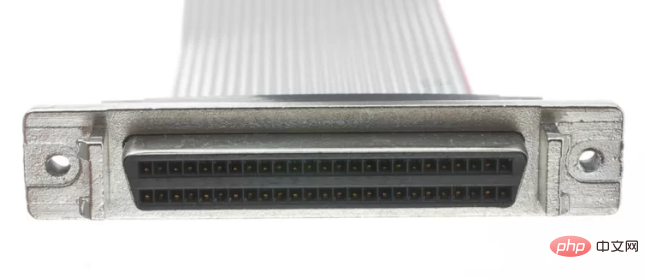What interface is scsi?
scsi is the small computer system interface, the abbreviation of "Small Computer System Interface"; the interface is an independent processor standard for system-level interfaces between computers and peripheral devices, on the scsi bus Can connect host adapter and eight scsi peripheral controllers.

The operating environment of this tutorial: Windows 10 system, DELL G3 computer.
What is scsi interface
Small Computer System Interface (SCSI, Small Computer System Interface) is a type of interface used between computers and peripheral devices (hard disk, floppy drive, optical drive, Processor-independent standard for system-level interfaces (printers, scanners, etc.).
The SCSI standard defines commands, communication protocols, and electrical characteristics of entities (in OSI terms, it occupies the physical layer, link layer, socket layer, and application layer). The largest number of applications are in Storage devices (such as hard disks, tape drives); however, in fact, devices that can be connected to SCSI include scanners, optical devices (such as CDs, DVDs), printers, etc. The SCSI command lists the supported devices SCSI Peripherals. Theoretically, it is impossible for SCSI to connect all devices, so the parameter "1Fh - unknown or no device type" exists.
The SCSI interface is a universal interface. The host adapter and eight SCSI peripheral controllers can be connected to the SCSI bus. The peripherals can include disks, tapes, CD-ROMs, rewritable optical disk drives, printers, Scanners and communication equipment, etc.
SCSI is a multi-tasking interface with bus arbitration function. Multiple peripherals hanging on a SCSI bus can work simultaneously. Devices on SCSI share the bus equally.
The SCSI interface can transmit data synchronously or asynchronously. The synchronous transmission rate can reach 10MB/s, and the asynchronous transmission rate can reach 1.5MB/s.
When the SCSI interface is connected to an external device. Its connecting cable can be up to 6m long.

Type extension:
SCSI-1
SCSI-1 is the most original version, with asynchronous transmission frequency of 3MB/S and synchronous transmission frequency of 5MB/s. Although almost eliminated, it is still used in some scanners and internal ZIP drives, using a 25-pin interface. In other words, if you connect a SCSI-1 device to your SCSI card, you must have an internal 25- to 50-pin interface cable; if you use an external device, you cannot use any of the internal interfaces (that is, at this time None of the internal interfaces can be used).
SCSI-2
The early SCSI-2, called FastSCSI, increased the data transfer rate from the original 5MB/s to 10MB/s, supports 8-bit parallel data transmission, and can connect 7 peripherals. Later, WideSCSI supported 16-bit parallel data transmission, the data transmission rate was also increased to 20MB/s, and 16 peripherals could be connected. This version of SCSI uses a 50-pin interface and is mainly used in scanners, CD-ROM drives, and older hard disks.
SCSI-3
In 1995, a higher-speed SCSI-3 was born, called UltraSCSI, with a data transfer rate of 20MB/s. It increases the synchronous transmission clock frequency to 20MB/s, a technology that improves the data transfer rate. If you use the Wide mode of 16-bit transmission, the data transfer rate can be increased to 40MB/s. This version of SCSI uses a 68-pin interface and is mainly used on hard drives. The typical feature of SCSI-3 is to greatly increase the bus frequency and reduce signal interference to enhance its stability.
There are many models of SCSI-3. Ultra (fast-20) has a transmission frequency of 20MHz, a data bandwidth of 8 bits, and a transmission rate of 20MBps
Ultra wide has a transmission frequency of 20MHz and a data bandwidth of 16 bits, transmission rate 40MBps
Ultra 2 has a transmission frequency of 80MHz, data bandwidth is 16 bits, and transmission rate is 80MBps
Ultra 160 has a transmission frequency of 80MHz, data bandwidth is 16 bits, and transmission rate is 160MBps
Ultra 320 has a transmission frequency of 80MHz, a data bandwidth of 16 bits, and a transmission rate of 320MBps
Ultra 640 has a transmission frequency of 160MHz, a data bandwidth of 16 bits, and a transmission rate of 640MBps
More For more related knowledge, please visit the FAQ column!
The above is the detailed content of What interface is scsi?. For more information, please follow other related articles on the PHP Chinese website!

Hot AI Tools

Undresser.AI Undress
AI-powered app for creating realistic nude photos

AI Clothes Remover
Online AI tool for removing clothes from photos.

Undress AI Tool
Undress images for free

Clothoff.io
AI clothes remover

Video Face Swap
Swap faces in any video effortlessly with our completely free AI face swap tool!

Hot Article

Hot Tools

Notepad++7.3.1
Easy-to-use and free code editor

SublimeText3 Chinese version
Chinese version, very easy to use

Zend Studio 13.0.1
Powerful PHP integrated development environment

Dreamweaver CS6
Visual web development tools

SublimeText3 Mac version
God-level code editing software (SublimeText3)

Hot Topics
 What are the internal interfaces of a computer motherboard? Recommended introduction to the internal interfaces of a computer motherboard
Mar 12, 2024 pm 04:34 PM
What are the internal interfaces of a computer motherboard? Recommended introduction to the internal interfaces of a computer motherboard
Mar 12, 2024 pm 04:34 PM
When we assemble the computer, although the installation process is simple, we often encounter problems in the wiring. Often, users mistakenly plug the power supply line of the CPU radiator into the SYS_FAN. Although the fan can rotate, it may not work when the computer is turned on. There will be an F1 error "CPUFanError", which also causes the CPU cooler to be unable to adjust the speed intelligently. Let's share the common knowledge about the CPU_FAN, SYS_FAN, CHA_FAN, and CPU_OPT interfaces on the computer motherboard. Popular science on the CPU_FAN, SYS_FAN, CHA_FAN, and CPU_OPT interfaces on the computer motherboard 1. CPU_FANCPU_FAN is a dedicated interface for the CPU radiator and works at 12V
 Common programming paradigms and design patterns in Go language
Mar 04, 2024 pm 06:06 PM
Common programming paradigms and design patterns in Go language
Mar 04, 2024 pm 06:06 PM
As a modern and efficient programming language, Go language has rich programming paradigms and design patterns that can help developers write high-quality, maintainable code. This article will introduce common programming paradigms and design patterns in the Go language and provide specific code examples. 1. Object-oriented programming In the Go language, you can use structures and methods to implement object-oriented programming. By defining a structure and binding methods to the structure, the object-oriented features of data encapsulation and behavior binding can be achieved. packagemaini
 Introduction to PHP interfaces and how to define them
Mar 23, 2024 am 09:00 AM
Introduction to PHP interfaces and how to define them
Mar 23, 2024 am 09:00 AM
Introduction to PHP interface and how it is defined. PHP is an open source scripting language widely used in Web development. It is flexible, simple, and powerful. In PHP, an interface is a tool that defines common methods between multiple classes, achieving polymorphism and making code more flexible and reusable. This article will introduce the concept of PHP interfaces and how to define them, and provide specific code examples to demonstrate their usage. 1. PHP interface concept Interface plays an important role in object-oriented programming, defining the class application
 Solution to NotImplementedError()
Mar 01, 2024 pm 03:10 PM
Solution to NotImplementedError()
Mar 01, 2024 pm 03:10 PM
The reason for the error is in python. The reason why NotImplementedError() is thrown in Tornado may be because an abstract method or interface is not implemented. These methods or interfaces are declared in the parent class but not implemented in the child class. Subclasses need to implement these methods or interfaces to work properly. How to solve this problem is to implement the abstract method or interface declared by the parent class in the child class. If you are using a class to inherit from another class and you see this error, you should implement all the abstract methods declared in the parent class in the child class. If you are using an interface and you see this error, you should implement all methods declared in the interface in the class that implements the interface. If you are not sure which
 Application of interfaces and abstract classes in design patterns in Java
May 01, 2024 pm 06:33 PM
Application of interfaces and abstract classes in design patterns in Java
May 01, 2024 pm 06:33 PM
Interfaces and abstract classes are used in design patterns for decoupling and extensibility. Interfaces define method signatures, abstract classes provide partial implementation, and subclasses must implement unimplemented methods. In the strategy pattern, the interface is used to define the algorithm, and the abstract class or concrete class provides the implementation, allowing dynamic switching of algorithms. In the observer pattern, interfaces are used to define observer behavior, and abstract or concrete classes are used to subscribe and publish notifications. In the adapter pattern, interfaces are used to adapt existing classes. Abstract classes or concrete classes can implement compatible interfaces, allowing interaction with original code.
 Insight into Hongmeng system: actual function measurement and usage experience
Mar 23, 2024 am 10:45 AM
Insight into Hongmeng system: actual function measurement and usage experience
Mar 23, 2024 am 10:45 AM
As a new operating system launched by Huawei, Hongmeng system has caused quite a stir in the industry. As a new attempt by Huawei after the US ban, Hongmeng system has high hopes and expectations. Recently, I was fortunate enough to get a Huawei mobile phone equipped with Hongmeng system. After a period of use and actual testing, I will share some functional testing and usage experience of Hongmeng system. First, let’s take a look at the interface and functions of Hongmeng system. The Hongmeng system adopts Huawei's own design style as a whole, which is simple, clear and smooth in operation. On the desktop, various
 Inner class implementation of interfaces and abstract classes in Java
Apr 30, 2024 pm 02:03 PM
Inner class implementation of interfaces and abstract classes in Java
Apr 30, 2024 pm 02:03 PM
Java allows inner classes to be defined within interfaces and abstract classes, providing flexibility for code reuse and modularization. Inner classes in interfaces can implement specific functions, while inner classes in abstract classes can define general functions, and subclasses provide concrete implementations.
 What is the difference between interfaces and abstract classes in PHP?
Jun 04, 2024 am 09:17 AM
What is the difference between interfaces and abstract classes in PHP?
Jun 04, 2024 am 09:17 AM
Interfaces and abstract classes are used to create extensible PHP code, and there is the following key difference between them: Interfaces enforce through implementation, while abstract classes enforce through inheritance. Interfaces cannot contain concrete methods, while abstract classes can. A class can implement multiple interfaces, but can only inherit from one abstract class. Interfaces cannot be instantiated, but abstract classes can.





